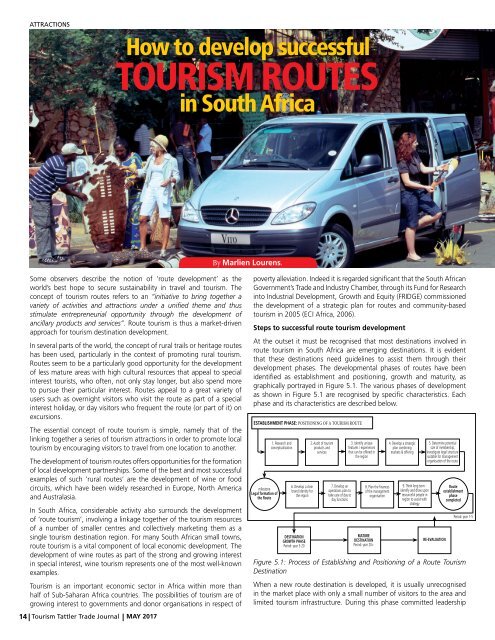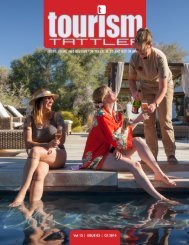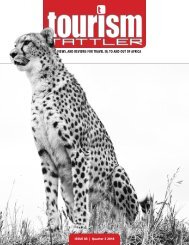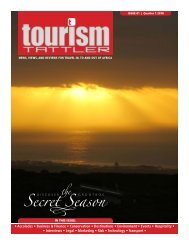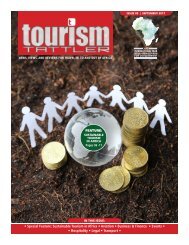Tourism Tattler May 2017 Edition
Our May edition features Karongwe Portfolio, Hotel Verde and Jaci’s Lodges - three prime examples of eco-friendly properties in South Africa who meet, and even exceed expectations as outlined in the UNWTO 2017 International Year of Sustainable Tourism for Development initiative.
Our May edition features Karongwe Portfolio, Hotel Verde and Jaci’s Lodges - three prime examples of eco-friendly properties in South Africa who meet, and even exceed expectations as outlined in the UNWTO 2017 International Year of Sustainable Tourism for Development initiative.
Create successful ePaper yourself
Turn your PDF publications into a flip-book with our unique Google optimized e-Paper software.
ATTRACTIONS<br />
How to develop successful<br />
TOURISM ROUTES<br />
in South Africa<br />
By Marlien Lourens.<br />
Some observers describe the notion of ‘route development’ as the<br />
world’s best hope to secure sustainability in travel and tourism. The<br />
concept of tourism routes refers to an “initiative to bring together a<br />
variety of activities and attractions under a unified theme and thus<br />
stimulate entrepreneurial opportunity through the development of<br />
ancillary products and services”. Route tourism is thus a market-driven<br />
approach for tourism destination development.<br />
In several parts of the world, the concept of rural trails or heritage routes<br />
has been used, particularly in the context of promoting rural tourism.<br />
Routes seem to be a particularly good opportunity for the development<br />
of less mature areas with high cultural resources that appeal to special<br />
interest tourists, who often, not only stay longer, but also spend more<br />
to pursue their particular interest. Routes appeal to a great variety of<br />
users such as overnight visitors who visit the route as part of a special<br />
interest holiday, or day visitors who frequent the route (or part of it) on<br />
excursions.<br />
The essential concept of route tourism is simple, namely that of the<br />
linking together a series of tourism attractions in order to promote local<br />
tourism by encouraging visitors to travel from one location to another.<br />
The development of tourism routes offers opportunities for the formation<br />
of local development partnerships. Some of the best and most successful<br />
examples of such ‘rural routes’ are the development of wine or food<br />
circuits, which have been widely researched in Europe, North America<br />
and Australasia.<br />
In South Africa, considerable activity also surrounds the development<br />
of ‘route tourism’, involving a linkage together of the tourism resources<br />
of a number of smaller centres and collectively marketing them as a<br />
single tourism destination region. For many South African small towns,<br />
route tourism is a vital component of local economic development. The<br />
development of wine routes as part of the strong and growing interest<br />
in special interest, wine tourism represents one of the most well-known<br />
examples.<br />
<strong>Tourism</strong> is an important economic sector in Africa within more than<br />
half of Sub-Saharan Africa countries. The possibilities of tourism are of<br />
growing interest to governments and donor organisations in respect of<br />
14 <strong>Tourism</strong> <strong>Tattler</strong> Trade Journal<br />
MAY <strong>2017</strong><br />
poverty alleviation. Indeed it is regarded significant that the South African<br />
Government’s Trade and Industry Chamber, through its Fund for Research<br />
into Industrial Development, Growth and Equity (FRIDGE) commissioned<br />
the development of a strategic plan for routes and community-based<br />
tourism in 2005 (ECI Africa, 2006).<br />
Steps to successful route tourism development<br />
At the outset it must be recognised that most destinations involved in<br />
route tourism in South Africa are emerging destinations. It is evident<br />
that these destinations need guidelines to assist them through their<br />
development phases. The developmental phases of routes have been<br />
identified as establishment and positioning, growth and maturity, as<br />
graphically portrayed in Figure 5.1. The various phases of development<br />
as shown in Figure 5.1 are recognised by specific characteristics. Each<br />
phase and its characteristics are described below.<br />
ESTABLISHMENT PHASE: POSITIONING OF A TOURISM ROUTE<br />
milestone<br />
Legal formation of<br />
the Route<br />
1. Research and<br />
conceptualisation<br />
6. Develop a clear<br />
brand identity for<br />
the region<br />
DESTINATION<br />
GROWTH PHASE<br />
Period: year 5-20<br />
2. Audit of tourism<br />
products and<br />
services<br />
7. Develop an<br />
operations plan to<br />
take care of day to<br />
day functions<br />
3. Identify unique<br />
features / experiences<br />
that can be offered in<br />
the region<br />
8. Plan the finances<br />
of the management<br />
organisation<br />
MATURE<br />
DESTINATION<br />
Period: year 20+<br />
4. Develop a strategic<br />
plan combining<br />
markets & offering<br />
9. Think long term -<br />
identify and draw upon<br />
resourceful people in<br />
region to assist with<br />
strategy<br />
5. Determine potential<br />
size of membership,<br />
investigate legal structure<br />
suitable for management<br />
organisation of the route<br />
RE-EVALUATION<br />
Route<br />
establishment<br />
phase<br />
completed<br />
Period: year 1-5<br />
Figure 5.1: Process of Establishing and Positioning of a Route <strong>Tourism</strong><br />
Destination<br />
When a new route destination is developed, it is usually unrecognised<br />
in the market place with only a small number of visitors to the area and<br />
limited tourism infrastructure. During this phase committed leadership


